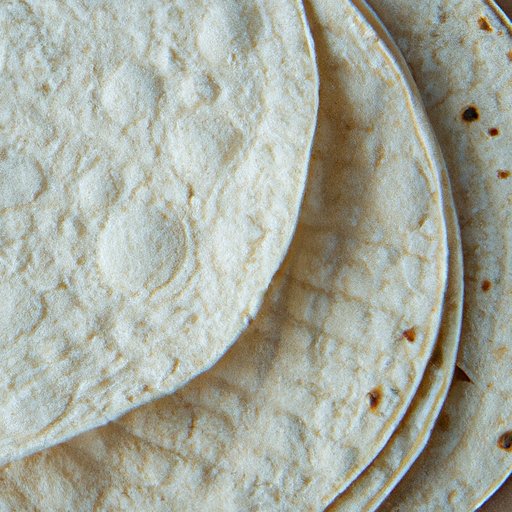Introduction
Tortillas are a staple in many diets around the world. They are a type of flatbread made from either corn or flour, and can be used as a wrap for sandwiches, tacos, burritos, and more. But which type of tortilla is healthier: corn or flour? In this article, we’ll explore the nutritional profiles of corn and flour tortillas, as well as the potential health benefits of eating them.

Comparing the Nutritional Profiles of Corn and Flour Tortillas
Let’s begin by taking a look at the nutritional profiles of corn and flour tortillas. According to the USDA, one large (6-inch) corn tortilla contains 109 calories, 2.2 grams of protein, 1.9 grams of fat, 22.7 grams of carbohydrates, and 1.7 grams of dietary fiber. On the other hand, one large (6-inch) flour tortilla contains 140 calories, 3.8 grams of protein, 4.2 grams of fat, 23 grams of carbohydrates, and 1.4 grams of dietary fiber.
In terms of micronutrients, both types of tortillas are a good source of manganese, phosphorus, magnesium, zinc, selenium, iron, and thiamin. However, corn tortillas contain significantly more dietary fiber than flour tortillas, as well as a higher amount of several B vitamins, including folate, niacin, riboflavin, and pantothenic acid.

Examining the Health Benefits of Eating Corn or Flour Tortillas
Eating either type of tortilla can provide certain health benefits. For example, they can help with weight loss due to their low calorie and high fiber content. In addition, the complex carbohydrates found in tortillas can help regulate blood sugar levels, making them a good choice for people with diabetes or prediabetes.
“Tortillas, like other whole grains, are a great food to include in a healthy diet,” says registered dietitian nutritionist Melissa Rifkin. “They are packed with fiber, B vitamins, and minerals. Eating whole grains like tortillas can help keep you fuller longer, which may help with weight loss.”
Exploring the Gluten Content of Corn and Flour Tortillas
Another important factor to consider when deciding between corn or flour tortillas is their gluten content. Gluten is a type of protein found in certain grains, such as wheat, barley, and rye. For people with celiac disease or a gluten sensitivity, it is important to avoid foods containing gluten.
Corn tortillas are naturally gluten-free, since they are made from corn. However, flour tortillas are typically made from wheat flour, which does contain gluten. Some brands offer gluten-free flour tortillas, but it’s important to check the ingredients list to make sure the product does not contain any gluten-containing grains.
Investigating the Effect of Corn or Flour Tortillas on Blood Sugar Levels
Eating either type of tortilla can have an effect on your blood sugar levels. This is because all carbohydrates break down into glucose in the body, and the rate at which they do so is measured by the glycemic index (GI). The GI is a measure of how quickly a food raises your blood sugar levels after eating it. Foods with a lower GI are digested more slowly, resulting in a slower and steadier rise in blood sugar levels.
Corn tortillas have a lower GI than flour tortillas, meaning they are digested more slowly. According to the Harvard T.H. Chan School of Public Health, corn tortillas have a GI of 52, while flour tortillas have a GI of 70. This means that eating corn tortillas instead of flour tortillas can help regulate blood sugar levels more effectively.

Exploring the Role of Corn or Flour Tortillas in Diabetes Management
For people with diabetes, choosing the right types of carbohydrates is essential for managing blood sugar levels. Eating complex carbohydrates, such as corn or flour tortillas, can help stabilize blood sugar levels and reduce the risk of developing complications associated with diabetes. However, it’s important to note that eating too many carbohydrates can still lead to elevated blood sugar levels.
“The key is to balance the amount of carbs with other nutrients such as protein and fat to help slow down digestion and absorption of the carbs,” says Rifkin. “It’s also important to choose complex carbs, like whole grain tortillas, over simple carbs, such as white bread. Whole grains are a better choice because they provide more fiber and other nutrients.”
Evaluating the Environmental Impact of Corn or Flour Tortilla Production
It’s also important to consider the environmental impact of producing corn or flour tortillas. Corn and flour tortillas have different carbon footprints, as well as different water usage. Corn tortillas require less water to produce than flour tortillas, making them a more sustainable option.
“Corn tortillas have a lower water footprint than flour tortillas,” says Dr. David Cleveland, professor of geography at the University of California Santa Barbara. “The production of corn tortillas uses about 10 percent less water than flour tortillas, making them a more sustainable food choice.”
Conclusion
In conclusion, corn and flour tortillas both offer certain health benefits and can be enjoyed as part of a nutritious diet. Corn tortillas are lower in calories and higher in fiber than flour tortillas, and they have a lower glycemic index, making them a better choice for regulating blood sugar levels. In terms of their environmental impact, corn tortillas are more sustainable than flour tortillas, since they use less water during production. Ultimately, the best type of tortilla for you depends on your individual dietary needs and goals.
(Note: Is this article not meeting your expectations? Do you have knowledge or insights to share? Unlock new opportunities and expand your reach by joining our authors team. Click Registration to join us and share your expertise with our readers.)
